Blog Celebrating the Cultural Significance of Wristbands during Raksha Bandhan
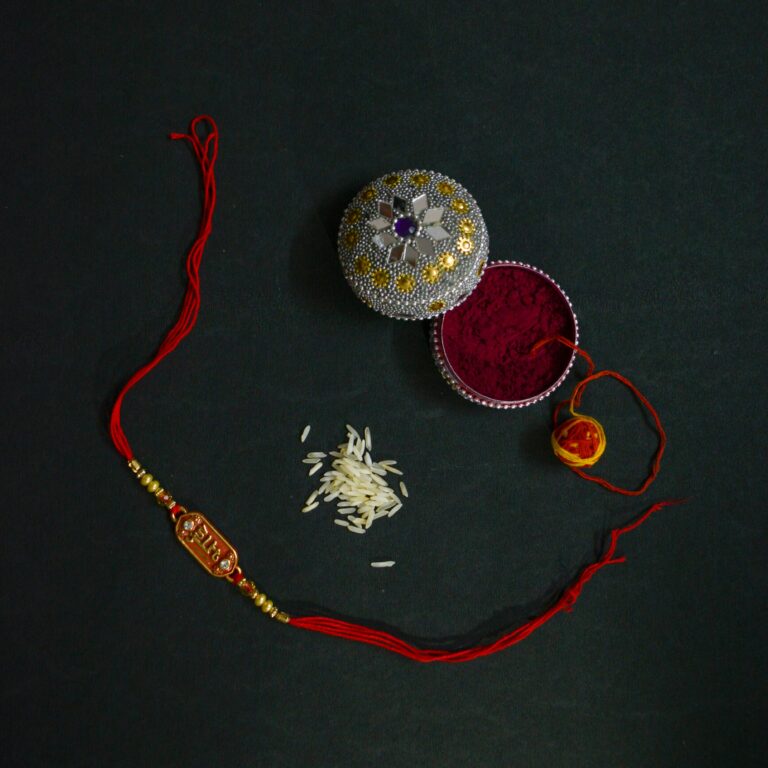
Wristbands reflect cultural significance during Raksha Bandhan by symbolising sibling protection and love, as a core part of the festival is the exchanging of rakhis to honour lifelong familial bonds. This cultural festival draws from deep historical practice, and today, it is one of the most important Indian traditions.
The exchanging of rakhis, or wristbands, during Raksha Bandhan is a central part of the festival, and the tradition holds significant cultural weight.
This article aims to explore this significance by first delving into the historical and religious background of Raksha Bandhan traditions. We will then explore the symbolic values associated with rakhi wristbands before discussing the diversity of rakhi designs across the various regions of India.
Finally, we will look at rakhis in a modern context, exploring their use in education, outreach, and cultural representation, as well as the wide range of personalisation and contemporary gifting trends that allow for a modern interpretation of rakhis.
Let’s get into it!

In many Hindu communities, Raksha Bandhan is celebrated with a ritual in which sisters tie a rakhi around their brother’s wrist.
This tradition is rooted in religious, royal and mythological origins. In Hindu mythology, it is told that Draupadi tied a thread around Krishna’s wrist, symbolising care and devotion. It is thought that this is the origin of tying a rakhi for Raksha Bandhan. The practice has been carried on throughout history, with many queens sending rakhis to neighbouring rulers to request protection or as a token of brotherhood.
In a religious context, the rakhis symbolise a sister’s prayer for well-being and her brother’s mutual promise to love and protect her. As a result, rakhis are a significant symbol of care, loyalty, and duty to one another.
As time has progressed, rakhis have evolved into beautifully crafted decorative wristbands. Modern rakhis are often customised with beads and motifs, and the practice has extended beyond just siblings exchanging wristbands. However, the emotional and cultural value of rakhis remains, as they continue to be a symbol of love, loyalty, and protection.
Drawing from this historical significance, modern rakhi now reaffirm and deepen this cultural tradition, and symbolise a deep expression of familial protection and connection.
In many traditions, rakhi wristbands are a representation of love, loyalty, and spiritual intention during Raksha Bandhan. The traditional ritual of a sister tying a rakhi on her brother’s wrist represents a mutual promise of protection, a prayer for well-being, and a sign of familial love.
While the wristband may be simple, it is, therefore, a strong reflection of an enduring connection and deep loyalty.
The different colours, textures, and materials used in rakhis carry cultural meaning. Red and gold threads often symbolise prosperity and protection, while green is a sign of growth and harmony. The use of white typically represents peace and purity, and orange symbolises energy or courage.
Additionally, the use of different materials, such as beads or silk threads, can be used to create culturally significant motifs, which deepens the meaning of the rakhi.
Today, modern rakhi designs reinterpret these traditional values, aligning historical tradition with a modern twist. Common reinterpretations include minimalist bracelets, eco-friendly designs, and handmade wristbands. Additionally, some now feature charms or personally meaningful symbols to create unique designs that celebrate the bond between two specific people.
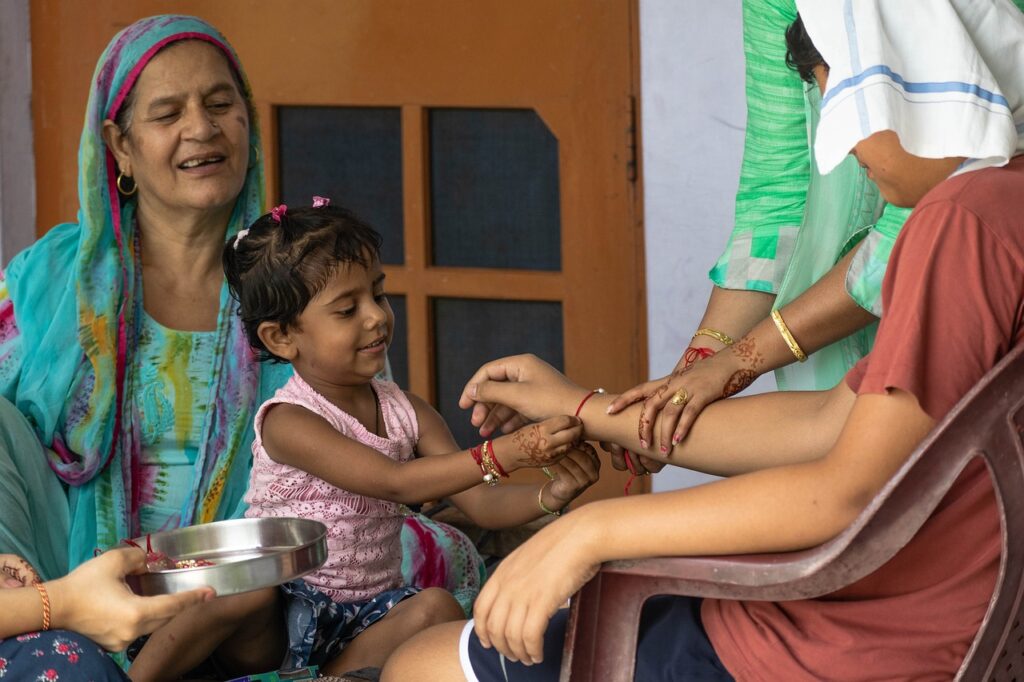
Rakhi wristbands can be crafted from a wide range of materials, each with its own emotional and cultural significance.
Traditionally, rakhis were crafted simply from cotton, and this still proves to be a popular option today. However, as time progressed, rakhis made from silk threads started to become more common, and often, these are adorned with beads and sequins to increase their meaning and add to their cultural significance.
Today, rakhis can be made from just about any material conceivable; however, there appears to be a growing trend for sustainable and eco-friendly wristbands. These wristbands are often made from sustainable fabrics, recycled paper, and jute, and adorned with metallic charms or ribbons to add deeper meanings. Modern rakhis symbolise the desire to honour tradition, but also respect and protect the planet.
Despite the changes that rakhis have seen, craftsmanship remains central to the design process. Each designer incorporates the wristbands with elements that represent and highlight personal and cultural identity, making the rakhis a token of affection and a symbol of love. Whether the wristband is handmade by the siblings themselves or crafted by an artisan, the crafting process is an important part of gifting rakhi.
Additionally, the choice of material used for the rakhi can affect its meaning and symbolic value. Handwoven threads can show signs of warmth and devotion, while opting for eco-friendly materials can represent care for family and the Earth. As the sustainability movement grows more prominent, rakhi designs and materials are slowly being shaped to reflect these eco-conscious principles.
Raksha Bandhan rituals differ across India, as regional beliefs and traditions influence the symbolism and materials used in the presentation of rakhi wristbands.
In many North Indian states, Raksha Bandhan rituals include a large family gathering, in which the sisters of the family often perform a ritual of worship and apply a tilak on their brother’s forehead. After this, they tie the rakhi, which are typically ornate wristbands featuring red and gold threads, as well as beads.
In South India, Raksha Bandhan overlaps with the festival of Avani Avittam, which involves a sacred thread changing ceremony for Brahmin men. The rakhis used in this part of India are often simpler than others, with cotton and silk thread wristbands being common.
In the East, specifically in West Bengal and Odisha, rakhis are part of the festival of Jhulan Purnima, which celebrates Krishna and Radha. During the festival, sisters tie delicate and often minimalist threads to their brothers’ wrists. However, rakhis are also given by many other people in the community, and it is common for people to tie rakhis on close friends or even neighbours.
In West India, the festival coincides with another festival, Narali Purnima, which is dedicated to Varuna (the sea god). Rakhis tied during this time often reflect local traditions, with mirror work or motifs relevant to their community being common features.
The regional differences between rakhis demonstrate how closely the tradition is tied to local and personal identity. Furthermore, in diaspora communities, it is now common to see regional practices from across India blended for Raksha Bandhan, creating a modern expression of the festival that honours tradition but also represents present-day life.
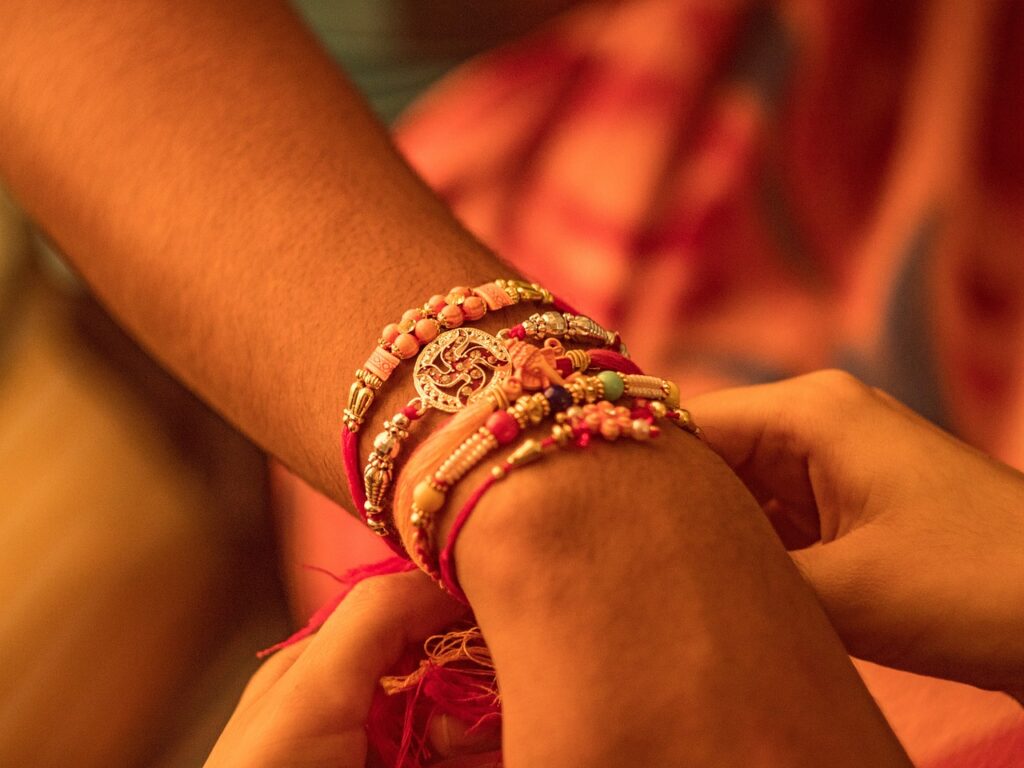
As modern wristband innovations have created new design methods, there is now a significant opportunity to blend tradition with contemporary designs.
This extends to recent innovations in rakhi wristbands, as there are now many new ways to create traditional designs with a modern twist. This includes online personalisation tools, in which users can customise their rakhi designs online and create a wristband that is fully personalised to their needs.
These trends make Raksha Bandhan more accessible, as it increases the number of people who can participate, no matter where they are in the world. This is particularly true for younger generations who are spread out across the world, as it allows them to connect with the tradition of Raksha Bandhan in a modern context, while still preserving the emotional essence of the tradition.
Additionally, we are seeing many modern innovations in the design aspect of rakhi design, which is largely stemming from digital culture and fashion aesthetics, as well as influencer-driven designs, which are bringing a fresh interpretation of rakhi and providing new inspiration for design choices.
Looking ahead, we can expect rakhi design to develop even further, in line with technological advancements. We could soon see rakhis that utilise AI to create even more personalised designs, or integrated technological design elements such as lights or sound to make rakhis even more effective.
It is important to recognise our diverse population and ensure that traditions allow for participation from everyone. This includes rakhi wristbands, and there are many ways that they can be designed to ensure they are inclusive for a wide range of physical, sensory, and cognitive needs.
Many features can be incorporated into rakhi wristbands that can ensure they are inclusive. For example, adjustable bands allow for easy wearing and can be adapted to anyone’s wrist. Tactile embellishments can improve the sensory experience of the wristband and ensure that certain messages can be communicated via touch, and sensory-friendly materials make sure that the bands are comfortable for everyone.
Inclusive design is important, as it promotes greater participation in Raksha Bandhan within schools, communities and families. By including just a few thoughtful adaptations to rakhi, the tradition can become even more inclusive and allow a wider group of people to participate in the beautiful tradition.
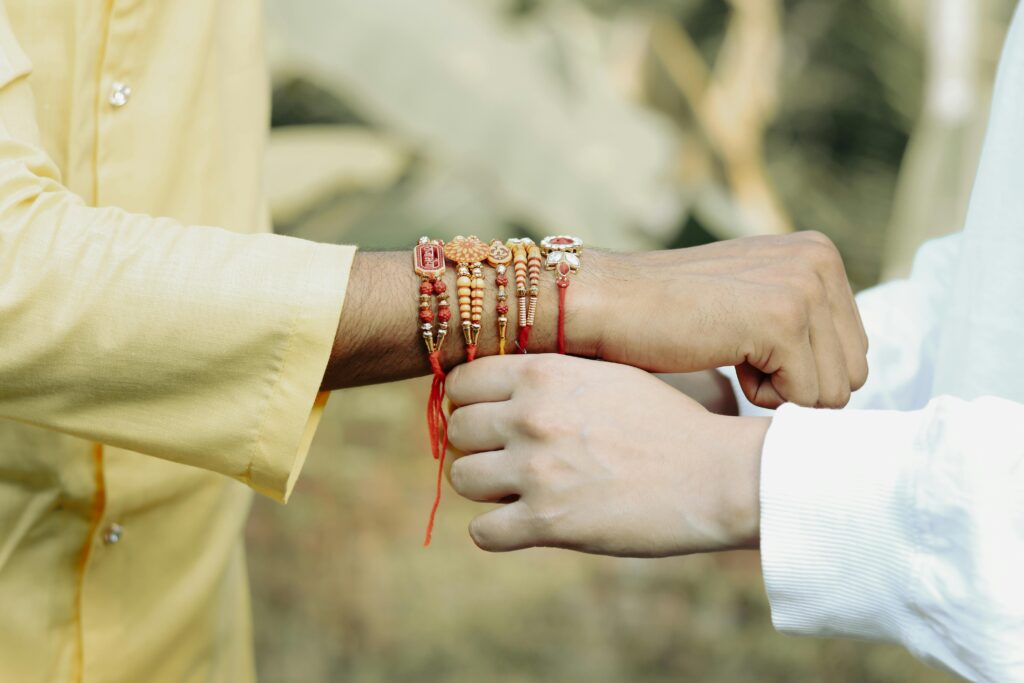
The central meaning behind gifting a rakhi is to honour and strengthen the sibling bond. This meaning can be deepened by creating customised and highly personalised gifts that are unique to siblings’ relationships.
Many customisation options can increase the personal nature of a rakhi wristband and make the gift even more special. Adding features such as tailored messages to your sibling, colours that hold significance, or traditional symbols can create emotional resonance and increase the cultural relevance of the wristband. These small details can take a rakhi to the next level and help to blend tradition with special elements that mean something to the wearer.
Many platforms that offer customisation allow the customised wristbands to be purchased in bundles, which is perfect for family groups or events. Purchasing several customised wristbands encourages coordinated and inclusive celebration across a whole family or group, and also ensures that each member receives a special and personalised rakhi.
This small act of thoughtful customisation therefore turns a simple gesture of gifting a loved one a rakhi wristband into a lasting keepsake of love and protection that they can wear with pride and look back on for many years to come.
Traditions must be widely taught to ensure their longevity, which is why it is key that the meaning of Raksha Bandhan needs to be kept alive through education and teaching. Luckily, rakhi provides an excellent opportunity as an educational tool to promote awareness of Raksha Bandhan in schools and communities.
In classrooms, rakhis can be used as a part of art-based learning or storytelling sessions to raise awareness. Cultural lessons that include DIY rakhi-making encourage students to interact with the rich history of the tradition, as well as their personal family history.
This can also be extended outside of the classroom into community outreach programs, in which members of the community are invited to participate in the tradition of rakhi and learn more about this cultural event.
Within families, symbolic storytelling through rakhi wristbands is a fantastic way for gaps to be bridged between older and younger generations, as older generations can teach younger members of their family about the unique stories and traditions that make Raksha Bandhan special to them, by using wristbands.
Early cultural education is key to shaping shared values and social understanding, which is why it is so important that children learn about traditions such as Raksha Bandhan. This ensures they develop a strong sense of cultural identity early on and understand the rich history and traditions that are special to their family and community.
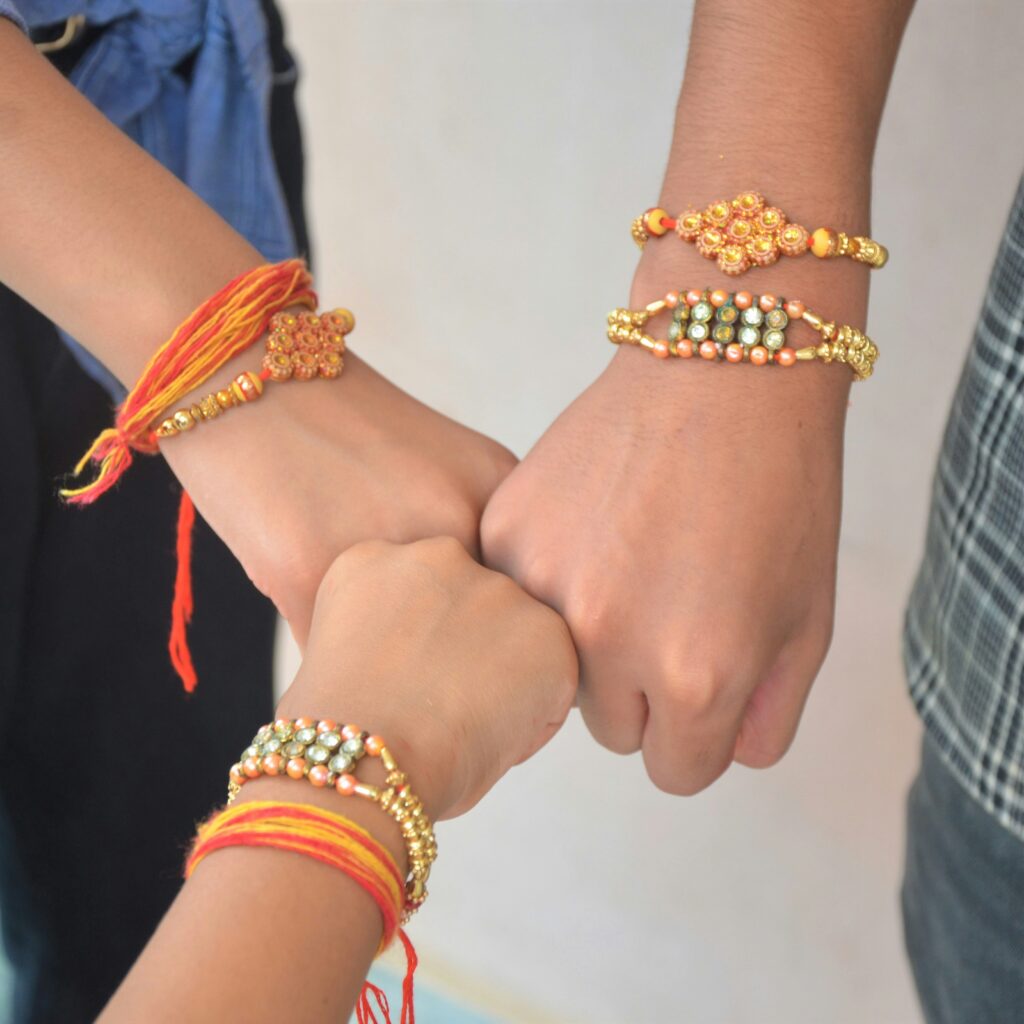
Brands and businesses are now leveraging wristbands to tell culturally relevant stories that reflect and honour Raksha Bandhan traditions, while also allowing emotional connections with consumers.
By offering thoughtfully designed rakhis that emphasise heritage and symbolic meaning, they can spread the message of Raksha Bandhan and create a unique and special product for customers. Not only does this thoughtful design help the brands to connect with consumers, but it also enhances the brand’s authenticity and visibility.
This approach isn’t confined to Raksha Bandhan, as these wristbands can be used in a wide range of other cultural events. For example, they can be used for gifting during Diwali, as tokens of goodwill and connection during Eid, and can even be integrated into weddings as a special personalised gift for guests. They can also be used as part of wider awareness campaigns to raise cultural awareness throughout the wider community.
The versatility of cultural wristbands, therefore, supports year-round storytelling and inclusivity by creating a wide platform for cultural resonance and education across a diverse audience.
Raksha Bandhan is a celebration steeped in history and tradition, and has significant cultural meaning to a wide group of people. The custom of gifting rakhis during this time has slowly evolved from giving sacred threads into creating personalised gifts that hold personal and cultural significance.
This evolution is largely due to the role of innovation and inclusivity, which has allowed for the creation of custom designs that have expanded the festival’s emotional and cultural resonance. Additionally, modern gifting options such as wristband bundles and personalised messages have allowed for deeper connections to be formed when gifting rakhi.
At The Wristband Co., we deeply respect the cultural and religious traditions surrounding Raksha Bandhan and do not intend to replace traditional rakhis. Rather, our custom wristbands offer a modern, complementary alternative for those seeking to celebrate the festival in a more contemporary or inclusive way.
Our intention is never to replace sacred customs but to support diverse expressions of connection, particularly for those living abroad, in schools, or in community groups who may be looking for inclusive ways to honour the spirit of Raksha Bandhan.
For those who may be interested, we offer eco-friendly fabric wristbands and customisable woven wristbands that can be personalised to reflect the colours, symbols, and sentiments of this special occasion. These options are designed simply as modern interpretations to complement (not substitute) the traditional rakhi.
If this sounds like an option that might interest you, please don’t hesitate to contact us via email at [email protected], or give us a call on 08 8363 4850 to chat to one of our friendly team members.


Join our mailing list to receive product information, endless inspiration and 10% off your next order!
Monday – Friday 8:30 AM-8:30 PM
Saturday 10:00 AM-5:00 PM
Sunday CLOSED
38 Little Rundle Street Kent Town SA 5067
08 8363 4850
ABN: 62 239 772 879
The Wristband Co. is located on the traditional lands for the Kaurna people, and we respect their spiritual relationship with their Country. We also acknowledge the Kaurna people as the custodians of the Adelaide region and that their cultural and heritage beliefs are still as important to the living Kaurna people today.
Payments Accepted